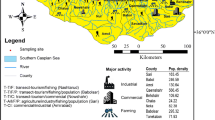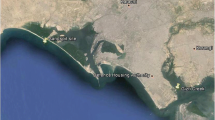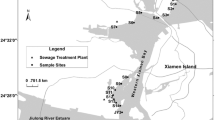Abstract
Geochemical investigations of tidal flat coastal sediments at Ogori, Ozuki, and Kasado in Yamaguchi Bay of southwest Japan were conducted to determine their metal concentrations and to assess contamination levels, compared with sediment quality guidelines (SQG) and several pollutant indicators. Selected major oxides, trace elements, and total sulfur (TS) were determined by X-ray fluorescence. pH values of most samples were alkaline, indicating anoxic conditions. Average abundances of As, Pb, Zn, Cu, Ni, and Cr in Ozuki sediments were 11, 27, 109, 21, 19, and 52 mg/kg, respectively, compared to 9, 29, 80, 16, 18, and 42 mg/kg at Ogori and 12, 27, 151, 34, 30 and 80 mg/kg at Kasado, respectively. Average concentrations of As, Zn, and Cu in all samples and TiO2, Fe2O3, and P2O5 at Kasado were greater than those of the upper continental crust. Contamination levels were assessed based on SQG, contamination factors (CF), pollution load index (PLI), enrichment factor (EF), and index of geoaccumulation (Igeo). According to the SQG of the US EPA, the sediments were heavily polluted with respect to As, whereas Zn, Cu, Ni, and Cr were classed as moderately polluted. The elevated CF values of As, Pb, and Zn identify moderate to considerable contamination, indicating that these metals are potentially toxic in the study area. Based on PLI and EF, the study sites are moderate to moderately severe polluted with As and Pb, moderately polluted with Zn, and weakly contaminated to noncontaminated with Cu, Ni, and Cr. The highest Igeo values for As, Pb, and Zn in the surface and core sediments reflected the tendency of metal contamination that seems to be related to their fine-grained nature, organic matter-rich sediments, and anthropogenic point sources. Trace metal contents were strongly correlated with Fe2O3 and TiO2, suggesting that Fe oxyhydroxides and detrital clastic load play a role in controlling abundances in the study area.






Similar content being viewed by others
References
Abu-Hilal, A. H. (1987). Distribution of trace elements in near shore surface sediments from the Jordan Gulf of Aqaba (Red Sea). Marine Pollution Bulletin, 18, 190–193.
Adams, R. H., Guzman Osorio, F. J., & Zavala Cruz, J. (2008). Water repellency in oil contaminated sandy and clayey soils. International journal of Environmental Science and Technology, 5(4), 445–454.
Agbozu, I. E., Ekweozor, I. K. E., & Opuene, K. (2007). Survey of heavy metals in the catfish Synodontis clarias. International journal of Environmental Science and Technology, 4(1), 93–98.
Ahmed, F., Bibi, M. H., Fukushima, T., Seto, K., Ishiga, H., Fukushima, T., et al. (2010). Abundances, distribution, and sources of trace metals in Nakaumi-Honjo coastal lagoon sediments, Japan. Environmental Monitoring and Assessment, 167, 473–491.
Akimoto, K., Nakahara, K., Kondo, H., Ishiga, H., & Dozen, K. (2004). Environmental reconstruction based on heavy metals, diatoms and benthic foraminifers in the Isahaya reclamation area, Nagasaki, Japan. Journal of Environmental Micropaleontology, Microbiology and Meiobenthology, 1, 83–104.
Akoto, O., Bruce, T. N., & Darko, G. (2008). Heavy metals pollution profiles in streams serving the Owabi reservoir. African Journal of Environmental Science and Technology, 2(11), 354–359.
Aktar, M. W., Paramasivam, M., Ganguly, M., Purkait, S., & Sengupta, D. (2010). Assessment and occurrence of various heavy metals in surface water of Ganga River around Kolkata: A study for toxicity and ecological impact. Environmental Monitoring and Assessment, 160(1–4), 207–213.
Arnason, J. G., & Fletcher, B. A. (2003). A 40+ year record of Cd, Hg, Pb, and U deposition in sediments of Patroon Reservoir, Albany County, NY, USA. Environmental Pollution, 123, 383–391.
Astrom, M. (1998). Partitioning of transition metals in oxidized and reduced zones of sulphide-bearing fine-grained sediments. Applied Geochemistry, 5, 607–617.
Axtmann, E. V., & Luoma, S. N. (1991). Large-scale distribution of metal contamination in the fine-grained sediments of the Clark Fork River, Montana, U.S.A. Applied Geochemistry, 6(Luoma SN), 75–88.
Bibi, M. H., Ahmed, F., Ishiga, H., Asaeda, H., & Fujino, T. (2010). Present environment of Dam Lake Sambe, southwestern Japan: A geochemical study of bottom sediments. Environmental Earth Science, 60, 655–670.
Boxall, A. B. A., Comber, S. D., Conrad, A. D., Howcroft, J., & Zaman, N. (2000). Inputs, monitoring and fate modeling of antifouling biocides in UK estuaries. Marine Pollution Bulletin, 40, 898–950.
Chandrajith, R. L. R., Okumura, M., & Hashitani, H. (1995). Human influence on the Hg pollution in Lake Jinzai, Japan. Applied Geochemistry, 10, 229–235.
Chilvers, D. C., & Peterson, P. J. (1987). Global cycling of arsenic. In T. C. Hutchinson & K. M. Meema (Eds.), Lead, mercury, cadmium and arsenic in the environment (pp. 279–301). New York: Wiley.
Daskalakis, K. D., & O’Connor, T. P. (1995). Distribution of chemical concentrations in US coastal and estuarine sediment. Marine Environmental Research, 40(4), 381–398.
Deely, J. M., & Ferguson, J. E. (1994). Heavy metal and organic matter concentrations and distributions in dated sediments of a small estuary adjacent to a small urban area. Science of the Total Environment, 153, 97–111.
Farmer, J. G., & Lovell, M. A. (1986). Natural enrichment of arsenic in Loch Lomond sediments. Geochemica et Cosmochim Acta, 50, 2059–2067.
Forstner, U., & Wittmann, G. T. W. (1979). Metal pollution in the aquatic environment (p. 486). Berlin: Springer.
Gueu, S., Yao, B., Adouby, K., & Ado, G. (2007). Kinetics and thermodynamics study of lead adsorption on to activated carbons from coconut and seed hull of the palm tree. International journal of Environmental Science and Technology, 4(1), 11–17.
Hakanson, L. (1980). Ecological risk index for aquatic pollution control. A sedimentological approach. Water Research, 14, 975–1001.
Hobbelen, P. H. F., Koolhaas, J. E., & Van Gestel, C. A. M. (2004). Risk assessment of heavy metal pollution for detritivores in floodplain soils in the Biesbosch, the Netherlands, taking bioavailability into account. Environmental Pollution, 129(3), 409–419.
Hoshika, A., & Shiozawa, T. (1984a). Sedimentation rates and heavy metal pollution of sediments in the Seto Inland Sea, Part 2, Hiroshima Bay. Journal of the Oceanographical Society of Japan, 40, 115–123.
Hoshika, A., & Shiozawa, T. (1984b). Sedimentation rates and heavy metal pollution of sediments in the Seto Inland Sea, Part 3, Hiuchi-Nada. Journal of the Oceanographical Society of Japan, 40, 334–342.
Hoshika, A., & Shiozawa, T. (1985). Sedimentation rates and heavy metal pollution of sediments in the Seto Inland Sea, Part 4, Suho-Nada. Journal of the Oceanographical Society of Japan, 41, 283–290.
Hoshika, A., Shiozawa, T., & Matsumoto, E. (1983). Sedimentation rates and heavy metal pollution in sediments in Harima-Nada (Harima Sound), Seto Inland Sea. Journal of the Oceanographical Society of Japan, 39, 51–56.
Ishiga, H., Dozen, K., Ahmed, F., Bibi, M. H., & Kaita, M. (2003). Evaluation of sedimentary environment using a Zn-Fe2O3 diagram. Geoscience Reports of Shimane University Japan, 22, 15–20. in Japanese.
Karbassi, A. R., Monavari, S. M., Bidhendi, G. R. N., Nouri, J., & Nematpour, K. (2008). Metal pollution assessment of sediment and water in the Shur River. Environmental Monitoring and Assessment, 147(1–3), 107–116.
Klinkhammer, G. P. (1980). Early diagenesis in sediments from the eastern equatorial Pacific. II. Porewater metal results. Earth and Planetary Science Letters, 46, 81–101.
Kurland, L. T., Faro, S. W., & Siedler, H. (1960). Minimata disease: The outlook of a neurological disorder in Minamata, Japan, and its relation to the ingestion of Seafood contaminated by mercuric compounds. World Neurology, 1, 370–395.
Loring, D. H., & Rantala, R. T. T. (1992). Manual for the geochemical analyses of marine sediments and suspended particulate matter. Earth-Science Reviews, 32, 235–283.
Matsumoto, E., & Yokota, S. (1978). Accumulation rate and heavy metal pollution in Osaka Bay sediments. Journal of the Oceanographical Society of Japan, 34, 108–115. in Japanese.
Millward, G. E., & Moore, R. M. (1982). The adsorption of Cu, Mn and Zn by iron oxyhydroxides in model estuarine solutions. Water Research, 16, 981–985.
MOE (Ministry of Environment, Japan) (2004). Environmental quality standards for soil pollution. Godochosha No. 5, 1-2-2 Kasumigaseki, Chiyoda-ku, Tokyo, Japan, 100-8975.
Muller, G. (1969). Index of geoaccumulation in the sediments of the Rhine River. Geological Journal, 2, 108–118.
Nath, B. N., Rao, V. P. C., & Becker, K. P. (1989). Geochemical evidence of terrigenous influence in deep-sea sediments up to 8°S in the Central Indian Basin. Marine Geology, 87, 301–313.
Nicolau, R., Galera-Cunha, A., & Lucas, Y. (2006). Transfer of nutrients and labile metals from the continent to the sea by a small Mediterranean river. Chemosphere, 63(3), 469–476.
Nitta, T. (1972). Marine pollution in Japan. In: M. Ruivo (Ed.) Marine pollution and sea life (pp. 77–81). West Byfleet: Fishing News (Books).
Nouri, J., Mahvi, A. H., Jahed, G. R., & Babaei, A. A. (2008). Regional distribution pattern of groundwater heavy metals resulting from agricultural activities. Environmental Geology, 55(6), 1337–1343.
Ogasawara, M. (1987). Trace element analysis of rock samples by X-ray fluorescence spectrometry, using Rh anode tube. Bulletin of the Geological Survey of Japan, 38(2), 57–68.
Perin, G., Bonardi, M., Fabris, R., Simoncini, B., Manente, S., Tosi, L., et al. (1997). Heavy metal pollution in central Venice Lagoon bottom sediments: evaluation of the metal bioavailability by geochemical speciation procedure. Environmental Technology, 18, 593–604.
Potts, P. J., Tindle, A. G., & Webb, P. C. (1992). Geochemical reference material compositions (p. 313). Caithness: Whittles.
Prohic, E., & Kniewald, G. (1987). Heavy metal distribution in recent sediments of the Kaka river estuary. An example of sequential extraction analysis. Marine Chemistry, 22, 279–297.
Rubio, B., Nombela, M. A., & Vilas, F. (2000). Geochemistry of major and trace elements in sediments of the Ria de Vigo (NW Spain): An assessment of metal pollution. Marine Pollution Bulletin, 40(11), 968–980.
Rudnick, R. L., & Gao, S. (2005). The crust. In H. D. Holland & K. K. Turekian (Eds.), Treatise on geochemistry, 3 (p. 537). Oxford: Elsevier Science.
SAIC (Science Applications International Corporation, Canada) (2002). Compilation and review of Canadian remediation guidelines, standards and regulations (Final report, B187-413, p. 79). Emergencies Engineering Technologies Office (EETO)—Environment Canada.
Salomons, W., & Forstner, U. (1984). Metals in hydrocycle (pp. 63–98). Berlin: Springer.
Sheikh, M. A., Noah, N. M., Tsuha, K., & Oomori, T. (2007). Occurrence of tributyltin compounds and characteristics of heavy metals. International Journal of Science and Technology, 4(1), 49–60.
Singh, M., Sharma, M., & Tobschall, H. J. (2005). Weathering of the Ganga alluvial plain, northern India: Implications from fluvial geochemistry of the Gomati River. Applied Geochemistry, 20, 1–21.
Soares, H. M. V. M., Boaventura, R. A. R., Machado, A. A. S. C., & Esteves da Silva, J. C. G. (1999). Sediments as monitors of heavy metal contamination in the Ave river basin (Portugal): Multivariate analysis of data. Environmental Pollution, 105, 311–323.
Sullivan, K. A., & Aller, R. C. (1996). Diagenetic cycling of arsenic in Amazon shelf sediments. Geochimica et Cosmochima Acta, 60, 1465–1477.
Suthar, S., & Singh, S. (2008). Vermicomposting of domestic waste by using two epigeic earthworms (Perionyx excavates and Perionyx sansibaricus). International journal of Environmental Science and Technology, 5(1), 99–106.
Taylor, S. R., & McLennan, S. M. (1985). The continental crust: Its composition and evolution. Oxford: Blackwell.
Terashima, S., & Ishihara, S. (1986). Copper, lead, zinc, arsenic and sulfur of the Japanese granitoids (3): Green tuff belt of Northeast Japan and Outer Zone of Southwest Japan. Bulletin of the Geology Survey of Japan, 37, 605–624.
Tessier, A., Carignan, R., & Belzile, N. (1994). Processes occurring at the sediment–water interface: Emphasis on trace elements. In J. Buffle & R. R. DeVitre (Eds.), Chemical and biological regulation of aquatic system (pp. 137–173). Boca Raton: Lewis.
Togashi, S., Imai, N., Okuyama-Kusunose, Y., Tanaka, T., Okai, T., Koma, T. & Murata, Y. (2000). Young upper crustal chemical composition of the orogenic Japan Arc. Geochemistry Geophysics Geosystems, 1(11), 1049, pp. 34.
Tomlinson, D. C., Wilson, J. G., Harris, C. R., & Jeffrey, D. W. (1980). Problems in the assessment of heavy-metal levels in estuaries and the formation of a pollution index. Helgoland Marine Research, 33, 566–575.
Tribovillard, N. P., Desprairies, A., Verges, E. L., Bertrand, P., & Moureau, N. (1994). Geochemical study of organic-matter rich cycles from the Kimmeridge Clay Formation of Yorkshire (UK): Productivity versus anoxia. Palaeogeography, Palaeoclimatology, Palaeoecology, 108, 165–181.
Turekian, K. L., & Wedepohl, K. H. (1961). Distribution of the elements in some major units of the Earth’s crust. Geological Society of American Bulletin, 72, 175–192.
Wisdom, H. L., Schroop, S. J., Calder, F. D., Ryan, J. D., Smith, R. G., Burney, L. C., et al. (1989). Natural trace metal concentrations in estuarine and coastal marine sediments of the Southeastern United States. Environmental Science and Technology, 23, 314–320.
Wong, P. T. S., Silverberg, B. A., Chau, Y. K., & Hodson, P. V. (1978). The biogeochemistry of lead in the environment (pp. 279–342). Amsterdam: Elsevier/North-Holland Biomedical Press.
Yang, H., & Rose, N. (2005). Trace element pollution records in some UK lake sediments, their history, influence, influence factors and regional differences. Environment International, 31, 63–75.
Yang, H., Rose, N. L., & Batterbee, R. W. (2002). Distributions of some trace metals in Lochnagar, a Scottish mountain lake ecosystem and its catchment. Science of the Total Environment, 285, 197–208.
Yoshida, K., Takahashi, G., & Imaoka, T. (2009). The Cretaceous Shiratakiyama cauldron in northwest Yamaguchi Prefecture, Japan: An example of asymmetric subsidence. The Journal of the Geological Society of Japan, 115(12), 643–657. in Japanese, with English abstract.
Yoshimura, C., Omura, T., Furumai, H., & Tockner, K. (2005). Present state of rivers and streams in Japan. River Research & Applications, 21, 93–112.
Zakir, H. M., Shikazono, N., & Otomo, K. (2008). Geochemical distribution of trace metals and assessment of anthropogenic pollution in sediments of old Nakagawa River, Tokyo, Japan. American Journal of Environmental Science, 4(6), 654–665.
Zhang, M., Xu, J., & Xie, P. (2007). Metals in surface sediments of large shallow eutrophic lake Chaohu, China. Bulletin of Environmental Contamination and Toxicology, 79, 242–245.
Zvinowanda, C. M., Okonkwo, J. O., Shabalala, P. N., & Agyei, N. M. (2009). A novel adsorbent for heavy metal remediation in aqueous environments. International journal of Environmental Science and Technology, 6(3), 425–434.
Acknowledgements
We thank Professor Toshiaki Irizuki for providing the core samples, Professor Yoshihiro Sawada of Shimane University for access to the XRF facilities and Yuya Shimizu and Erika Sano of Shimane University for their help with sampling. Dr. Barry Roser of Shimane University is acknowledged for his helpful comments on the manuscript.
Author information
Authors and Affiliations
Corresponding author
Rights and permissions
About this article
Cite this article
Rahman, M.A., Ishiga, H. Trace metal concentrations in tidal flat coastal sediments, Yamaguchi Prefecture, southwest Japan. Environ Monit Assess 184, 5755–5771 (2012). https://doi.org/10.1007/s10661-011-2379-x
Received:
Accepted:
Published:
Issue Date:
DOI: https://doi.org/10.1007/s10661-011-2379-x




